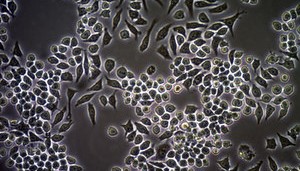Immortalized Murine Cells
 Murine cells show frequent spontaneous immortalization in contrast to human cells that almost never spontaneously immortalize. Addition of DNA tumor viruses alone, mild mutagen treatments and even deregulated expression of cellular genes such as c-myc are enough in certain murine cells for immortalization. Crisis stage is either not observed or is very subtle in case of murine cells, due to their ability to immortalize spontaneously, were exploited to identify genes associated with cellular mortal or immortal phenotypes. Independent studies on spontaneously immortalized clones from different strains of mouse have shown that most of these clones had one or both mutant p53 alleles, in contrast to their parent cells which expressed wild type p53. The immortal clones which expressed wild type p53 were found to be defective in one or other elements of the pRb pathway.
Creative Bioarray can provide you immortalized murine cell lines with an integrated platform for meeting the needs for virtually any relevant research project.
Murine cells show frequent spontaneous immortalization in contrast to human cells that almost never spontaneously immortalize. Addition of DNA tumor viruses alone, mild mutagen treatments and even deregulated expression of cellular genes such as c-myc are enough in certain murine cells for immortalization. Crisis stage is either not observed or is very subtle in case of murine cells, due to their ability to immortalize spontaneously, were exploited to identify genes associated with cellular mortal or immortal phenotypes. Independent studies on spontaneously immortalized clones from different strains of mouse have shown that most of these clones had one or both mutant p53 alleles, in contrast to their parent cells which expressed wild type p53. The immortal clones which expressed wild type p53 were found to be defective in one or other elements of the pRb pathway.
Creative Bioarray can provide you immortalized murine cell lines with an integrated platform for meeting the needs for virtually any relevant research project.
Description: The Immortalized Mouse Articular Chondrocytes are hygromycin-resistant, non-tumorigenic reversibly ...
Description: The Immortalized Mouse Cardiomyogenic Progenitor Cells are hygromycin-resistant, non-tumorigenic ...
Description: Immortalized Mouse Dental Apical Papilla Progenitor Cells are hygromycin-resistant, non-tumorigenic ...
Description: Intestinal epithelial cells provide a protective barrier against bacteria, antigens, and toxic ...
Description: Immortalized Mouse Achilles Tendon Cells (iMAT) are derived from the Achilles tendon of 4-week old ...
Description: Epidermal melanocytes are melanin-producing cells that function as a protective mechanism from ...
Description: Epidermal melanocytes are melanin-producing cells that function as a protective mechanism from ...
Description: Epidermal melanocytes are melanin-producing cells that function as a protective mechanism from ...
Description: Kaposi’s sarcoma-associated herpesvirus (KSHV) has been linked to several malignancies in AIDS ...
Description: The Immortalized Mouse CD4+CD8+T Cells (MOHITO) has characteristics of an immortalized cell line, ...
Description: Immortalized Mouse Renal Proximal Tubule Cells-SV40 have been obtained immortalizing Mouse Renal ...
Description: Odontoblasts are useful in studying the development of mineralized tissue, such as dentin. They are ...
Description: Immortalized Rat Suprachiasmatic Nucleus Cells (SCN2.2) is pluripotent and has the appearance of ...
Description: Epidermal melanocytes are melanin-producing cells that function as a protective mechanism from ...
Description: During preganancy the myometrium undergoes hypertrophy and hyperplasia. The established ...
Description: The Immortalized Mouse Urogenital Sinus Mesenchymal Cells (UGSM-2) are derived from a subline of ...